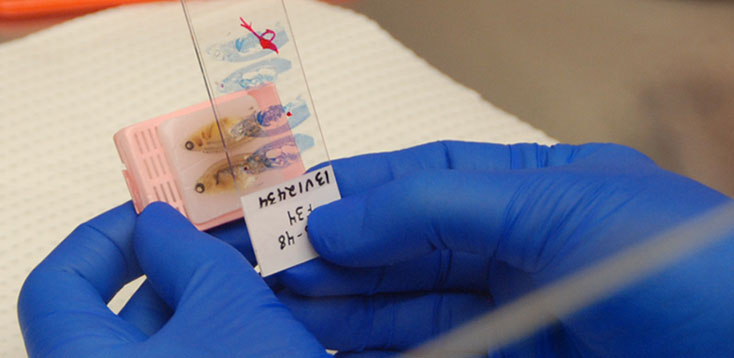Someday a little fish may make a big difference to your health, but not because it’s good to eat. The zebrafish, a tropical fish often found in home aquariums, is fast-replacing the white mouse as the most widely used tool in biomedical research.
Why are zebrafish so popular? Several features make them ideal laboratory subjects:
-
They are easy to breed and lay eggs in great quantities.
-
They are small and inexpensive to house.
-
The zebrafish embryo is transparent which allows researchers to observe development of their insides under various conditions.
-
They share many common biological features with humans like a backbone, a liver, a pancreas, kidneys, and intestines; their eyes have a retinal structure similar to humans; and their hearts have chambers that rhythmically pump blood through the body.
Zebrafish have been used to help find cures for cancer, to investigate chemical toxicity, and to understand human development.
With research institutions investing heavily in zebrafish projects, there is a critical need to identify and treat zebrafish disease. The OSU Veterinary Diagnostic Laboratory (VDL) is one of the few labs in the country that specializes in the identification of zebrafish diseases.
In a non-descript, cement-block building on the OSU campus, Donna Mulrooney, Molecular Diagnostic Laboratory Coordinator, opens a box full of filleted zebrafish mounted in paraffin. No bigger than your thumb, the waxed specimens are tested for disease by shaving off an extremely thin sample of tissue that is placed on a slide. Histology technicians then treat the slide with an acid-fast stain, turning the fish blue. Any pathogenic bacteria that may be present turn red. The fish and the slide are coded so Mulrooney can match them up and use the slide as a guide for extracting a tiny colony of bacteria for testing. This is one of 500-plus zebrafish that will be tested by the Veterinary Diagnostic Laboratory this year.
Dr. Michael Kent, an OSU professor with joint appointments in Microbiology and Veterinary Medicine, developed the first state-of-the-art molecular diagnostic test for diagnosing zebrafish disease. Dr. Christiane Lohr, a pathologist in the VDL and Dr. Danielle Meritet, NIH postdoc scholar, went on to develop the current array of tests used. Molecular diagnostic tests analyze genetic content for disease information. They focus on gene and protein activity patterns in different types of bacteria or viruses. Also called "molecular signatures," these patterns make diagnosis of disease faster and more specific than the traditional method of observing the appearance of pathogens under a microscope.
Dr. Kent has been investigating zebrafish disease for two decades. His laboratory developed the first pathogen-free zebrafish, and these fish are now provided to researchers all over the world through the Sinnhuber Aquatic Research Laboratory. They are the only pathogen-free zebrafish available and researchers value them because they ensure that laboratory results will not be impacted by the second- hand effects of infection.
The use of zebrafish as a model for biomedical research has increased exponentially in the past decade and OSU is on the cutting-edge of service to the scientists who are using them to make life-changing discoveries. Dr. Jerry Heidel, Director of the VDL, is gearing up to test ever increasing numbers of these important little swimmers. “The VDL expects submission of diagnostic specimens from zebrafish will increase significantly in the next few years,” says Dr. Heidel.










